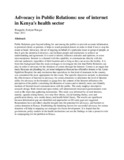| dc.description.abstract | Public Relations goes beyond talking for and among the publics to provide accurate information to potential clients or patients, it helps to reach potential donors in order to limit if not to stop the issues at hand. Advocacy, the act of arguing on behalf of a particular issue or group of people, so that it gets the attention it deserves, can facilitate people and institutions to achieve an understanding and agreement. It is used to inform, influence attitudes and opinions, or erase misconceptions. Internet is a channel with the capability to communicate directly with the relevant audiences, regardless of their location and as long as they can access the facility.
It is from this background that this study envisages to investigate the role that Public Relations can play in order to advocate for the donation of cornea through the Internet. Cornea is an organ that many Kenyans are pleading for, yet none indigenous Kenyan has offered to donate so far. Lions Sightfirst Hospital, the only institution that specializes in that kind of treatment in the country was considered the most appropriate for this study. The specific objectives include: to determine the effectiveness of Internet in advocacy for cornea donation; to determine the level of Internet utility for advocacy in the hospital; to gauge how the content of the Internet influences the perception of the public concerning the donation of cornea and to identify more user friendly medium of Internet based communication with the public.
The study employs descriptive research design. Both closed and open ended, self administered structured questionnaires were used as the main data-gathering instruments. This study was informed by several theories, namely; agenda setting theory, two-step flow theory, social learning theory, uses and gratification theory, new media theory and health belief theory. The results are significant because information gap are identified and approaches to fill some gaps are suggested. Respondents have provided valuable insights into the potential for advocacy, and barriers to cornea donation in Kenya. Establishing the hindering factors for successful advocacy for cornea donation will help in mapping out strategies for future development. It is hoped that the government, policy makers in the health institutions can use the findings to take a proactive role in campaigning for the problem in Kenya. | en_US |

